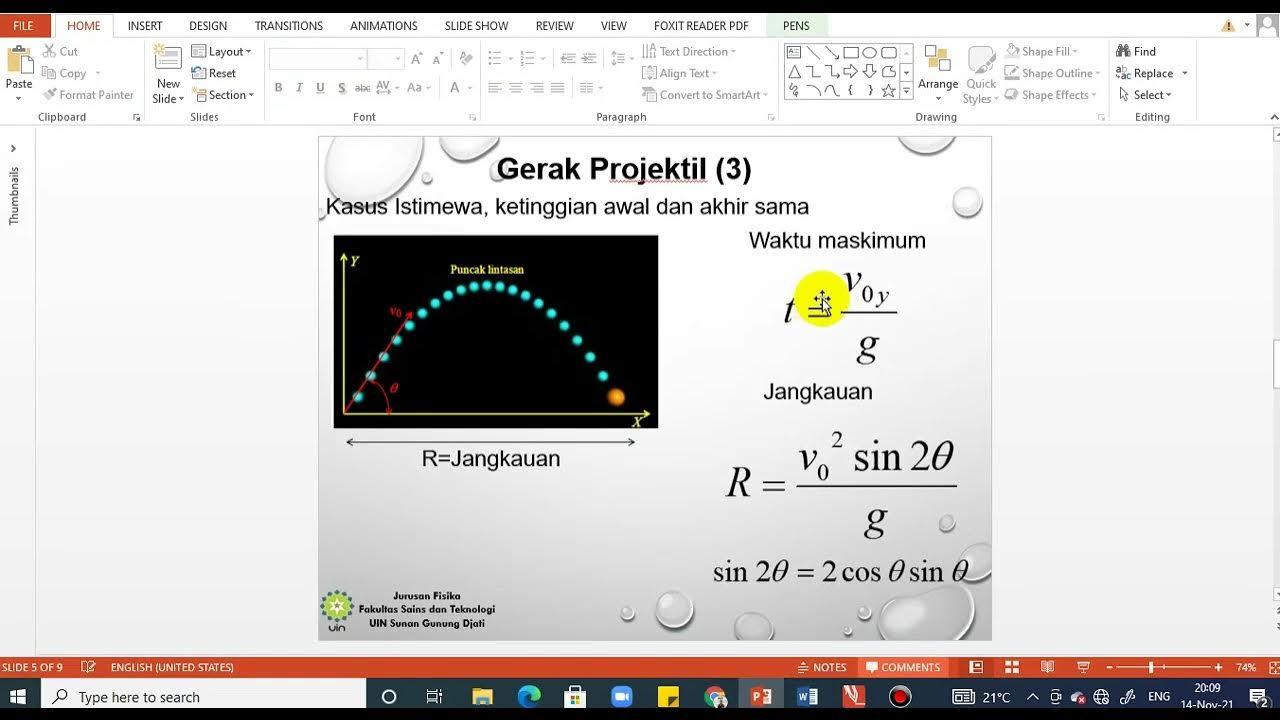Two Dimensional Motion (4 of 4) Horizontal Projection, Worked Example
Summary
TLDRIn this educational video, the host explains a two-dimensional projectile motion problem. An object is projected horizontally from a height of 45 meters with an initial velocity of 37 m/s. The video focuses on calculating the horizontal distance traveled by the object. The host clarifies that motion in the X and Y directions is independent, with zero acceleration in X and gravitational acceleration in Y. Using kinematic equations, the time of flight is determined to be 3.03 seconds, leading to a horizontal distance of 112 meters. The explanation is designed to help viewers understand the principles of projectile motion.
Takeaways
- 🎯 The problem involves calculating the horizontal distance traveled by an object in two-dimensional projectile motion.
- 📏 The object is projected from an initial height of 45 meters with an initial horizontal velocity of 37 m/s.
- 🔄 The motion in the X and Y directions are independent of each other.
- 🚫 In the X direction, there are no forces acting on the object, resulting in zero acceleration.
- 🌐 In the Y direction, the only force acting is gravity, causing a free-fall motion with an acceleration of -9.81 m/s².
- 📐 The kinematic equations are used to solve the problem, involving variables such as initial and final velocity, change in position, acceleration, and time.
- ⏱ The time taken for the object to move in the X direction is the same as the time taken to fall in the Y direction.
- 🔢 The time for the object to fall in the Y direction is calculated using the kinematic equation and the given values.
- 📉 The change in position in the Y direction is -45 meters, indicating a downward movement.
- 📏 The horizontal distance traveled in the X direction is calculated by multiplying the horizontal velocity by the time taken.
Q & A
What is the initial height from which the object is projected?
-The object is projected from an initial height of 45 meters.
What is the initial velocity of the object in the horizontal direction?
-The initial velocity of the object in the horizontal direction (X direction) is 37 meters per second.
What is the acceleration in the X direction?
-The acceleration in the X direction is zero meters per second squared because there are no forces acting on the object in that direction.
What is the acceleration in the Y direction?
-The acceleration in the Y direction is equal to the acceleration due to gravity on Earth, which is -9.81 meters per second squared.
What is the initial velocity in the Y direction for free fall motion?
-The initial velocity in the Y direction for free fall motion is 0 meters per second.
How do we determine the time it takes for the object to fall in the Y direction?
-We use the kinematic equation that relates change in position, initial velocity, time, and acceleration: \( \Delta y = v_{iy} \cdot t + \frac{1}{2} a_y \cdot t^2 \), where \( v_{iy} \) is the initial velocity in the Y direction, \( a_y \) is the acceleration in the Y direction, and \( \Delta y \) is the change in position in the Y direction.
What is the change in position in the Y direction?
-The change in position in the Y direction is -45 meters, indicating the object moves downward from its initial height.
How is the time it takes to fall in the Y direction related to the time in the X direction?
-The time it takes for the object to fall in the Y direction is the same as the time it takes to move horizontally in the X direction because the motion is simultaneous and independent in both directions.
How far does the object travel in the X direction?
-The object travels 112 meters in the X direction.
How long does it take for the object to travel the distance in the X direction?
-It takes 3.03 seconds for the object to travel the distance in the X direction.
What are the key steps to solve this projectile motion problem?
-The key steps include identifying the acceleration in both the X and Y directions, using the kinematic equations to find the time of flight in the Y direction, and then using that time to calculate the distance traveled in the X direction.
Outlines

Этот раздел доступен только подписчикам платных тарифов. Пожалуйста, перейдите на платный тариф для доступа.
Перейти на платный тарифMindmap

Этот раздел доступен только подписчикам платных тарифов. Пожалуйста, перейдите на платный тариф для доступа.
Перейти на платный тарифKeywords

Этот раздел доступен только подписчикам платных тарифов. Пожалуйста, перейдите на платный тариф для доступа.
Перейти на платный тарифHighlights

Этот раздел доступен только подписчикам платных тарифов. Пожалуйста, перейдите на платный тариф для доступа.
Перейти на платный тарифTranscripts

Этот раздел доступен только подписчикам платных тарифов. Пожалуйста, перейдите на платный тариф для доступа.
Перейти на платный тарифПосмотреть больше похожих видео

How Do Horizontally Launched Projectiles Behave? | Physics in Motion

Kinematics Part 3: Projectile Motion

Two Dimensional Motion Problems - Physics

Materi kuliah Fidas IF Gerak 2D

Projectile Motion Part 1| Grade 9 Science Quarter 4 Week 1 Lesson

12-88 | Engineering Dynamics Hibbeler 14th Edition | Engineers Academy
5.0 / 5 (0 votes)
